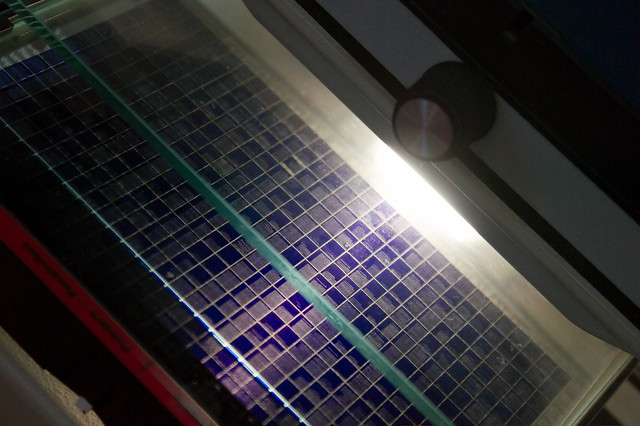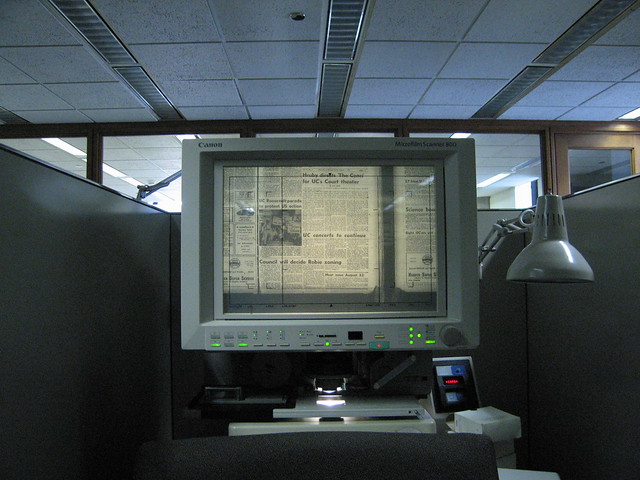#AtoZChallenge - M is for Microform, Maps, Military and Mylar
I'm probably going a bit overboard here but heck...it's my blog, I can do what I like yes? So first up some demystification of some library terminology.
Microform
This term covers microfiche and microfilm.
I'm always amazed when people don't know what microfiche is. But then I am getting on a bit and technology has raced ahead so why am I surprised?
Microfiche look a bit like transparent bits of blue pastic with tiny tiny writing on them. They are about 4 x 6 inches and often come in nice paper pockets to protect them.
They look like this
 |
| image from Frederic Bisson on Flicker Liseuse de microfiches Micron 355 |
Here are the readers at QFHS - my family history society.
Microfilm is pretty much the same, except it is on a reel usually in a nice little box sitting on a shelf or in a filing cabinet drawer. You look at it on a microfilm reader after you've loader the film as in this photo.
 |
| from Dale Winling - How I spend free time on flicker
I spent a lot of my youth at Mitchell Library scouring newspapers like this before Trove came along. Now I search all sorts of stuff on microfilm at archives e.g. wills and land records. Here is an example of a land record for one of my husband's ancestors that I took with my phone camera.
It is unlikely that you would have microfiche or microfilm at home but I thought I would mention them in case you are starting out and read about them or see them in a research facility but don't know what the heck they are.
Maps
Over the years I have bought a couple of maps when I have been trying to get a handle on where my ancestors lived. Gould Genealogy has been my supplier but I am keen to hear where else family historians purchase maps. Of course The Australian War Memorial has some good ones of battlefields et al.
Military
Speaking of war, maybe your ancestor served in one of the forces: army, navy or airforce. It can be difficult to get you head around all the military speak, the organisation of forces and how to go about looking for records and where they might be kept.
I have the following volumes in my library but hanker for more:
How to trace your military ancestors in Australia and New Zealand by R H Montague
Tracing Your Naval Ancestors by Simon Fowler
That elusive digger: tracing your military ancestor Neil C Smith
AIF Unit Histories of the Great War of 1914-1918 Ron Austin
Beautiful books to look at are published by Osprey which have great illustrations of uniforms and regalia e.g. Anzac Infantrymen
Digging for Diggers by Gareme Hosken is a great resource and I can't recommend it highly enough. That and Understanding Australian military speak by Neil C Smith are on my wishlist.
Of course if you are researching WWI ancestors you should read CEW Bean's official history of WWI.
This has been a very Australian focused list. It would be remiss of me if I didn't mention Pen & Sword Publishing which publish a phenomenal amount on military.
Mylar
If you wish to protect your maps and or other keepsakes from fingerprints, dust, creepy crawlies et al, then you probably want to invest in some Mylar. I first heard about Mylar when I joined Libraryland. I had to keep asking the name of it because I kept forgetting...so really this is more of an aide-memoir for me tee hee but...you might be interested in it too. Mylar is actually the name of the brand rather than the product (a bit like biro or kleenex). It is in fact plastic polyethylene terephthalate..yeah...easier to remember Mylar I think. If you want to see what it looks like go to this website here.
Right - that's More than enough from Me. Over to you.
|






Comments
It's nice to read such an Australian focused list. Well done.
----------
Sandra, Aspiring family historian, fellow participant in the #AtoZchallenge
Sandra's Ancestral Research Journal
The State Library of Victoria has some very nice microfilm readers and you can save the image on to a flash drive. There are lots of resources not yet digitised.
Regards
Anne
M is for Arrival in Melbourne of the Persian in 1854
----------
Anne Young
Anne's family history